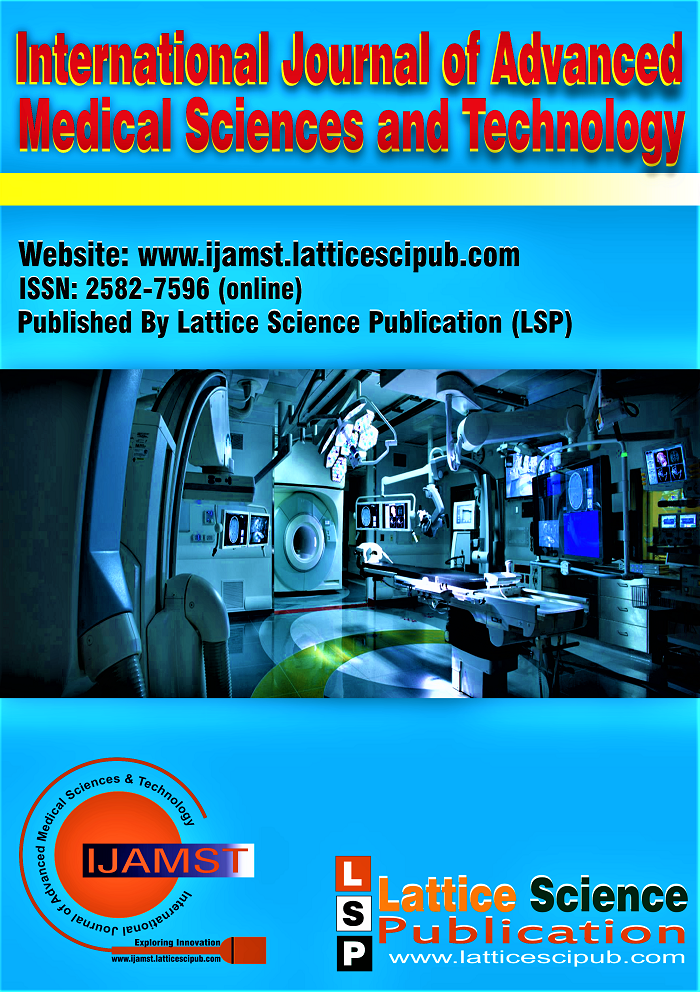Formulating Reliable Deep Acquisition Hypotheses for Medical Diagnosis Utilizing Explainable AI
Main Article Content
Abstract
The rise of deep learning has revolutionized various fields, including healthcare. Deep learning models excel at analyzing analyzable medical collections, such as surgical representations and EHRs, offering immense potential for improved medical diagnosis and decision-making. However, a significant barrier to their widespread adoption in clinical practice lies in their inherent "black-box" nature. This deficiency of transparence hinders reliance and raises concerns about accountability in critical medical decisions. This paper explores the concept of Explainable AI (XAI) for medical diagnosis, focusing on building trustworthy deep learning models for clinical decision support. We begin by highlighting the advantages of deep learning in medical diagnosis, emphasizing its ability to identify subtle patterns in data that may elude human experts. We then delve into the limitations of traditional deep learning models, explaining the challenges associated with their opacity and the impact on physician trust. Model-specific methods, on the other hand, leverage the inherent characteristics of specific deep learning architectures to provide insights into their decision-making processes. We then explore the integration of XAI with clinical workflows. This section emphasizes the importance of tailoring explanations to the needs of physicians, ensuring the information is clear, actionable, and aligns with established medical knowledge. We discuss strategies for visualizing explanations in a user-friendly format that facilitates physician understanding and promotes informed clinical decision-making. Furthermore, the paper addresses the ethical considerations surrounding XAI in healthcare. We explore issues like fairness, bias, and potential misuse of explanations. Mitigating bias in deep learning models and ensuring explanations are not misinterpreted become crucial aspects of building trustworthy systems. Finally, the paper concludes by outlining the future directions of XAI for medical diagnosis. We discuss the ongoing research efforts to develop more robust and user-centric XAI methods specifically suited for the complexities of medical data and decision-making. By fostering collaboration among AI researchers, medical professionals, and ethicists, we can develop trustworthy deep learning models that empower physicians and ultimately lead to enhanced patient care.
Downloads
Article Details

This work is licensed under a Creative Commons Attribution-NonCommercial-NoDerivatives 4.0 International License.
How to Cite
References
M. Kumar, S. Ali Khan, A. Bhatia, V. Sharma and P. Jain, "A Conceptual Introduction of Machine Learning Algorithms," 2023 1st International Conference on Intelligent Computing and Research Trends (ICRT), Roorkee, India, 2023, pp. 1-7,
DOI: https://doi.org/10.1109/ICRT57042.2023.10146676
BroArrieta, A. B., Díaz, N., Serna, J. A., Delgado, S., & Reyes-Luna, A. (2020). Explainable Artificial Intelligence (XAI) in Medicine: An Overview. Journal of Medical Imaging and Health Informatics, 10(8), 1682-1691. http://www.aspbs.com/jmihi/contents_jmihi2021.htm#v11n8
Bhatia, Abhay, and Anil Kumar. "AI Explainability and Trust in Cybersecurity Operations." Deep Learning Innovations for Securing Critical Infrastructures. IGI Global Scientific Publishing, 2025. 57-74. DOI: https://doi.org/10.4018/979-8-3373-0563-9.ch004
Ahmad, Muhammad Aurangzeb et al. “Interpretable Machine Learning in Healthcare.” 2018 IEEE International Conference on Healthcare Informatics (ICHI) (2018): 447-447. https://www.semanticscholar.org/paper/Interpretable-Machine-Learning-in-Healthcare-Ahmad-Teredesai/7d065e649e3bfc7d6d36166f50eab37b8404eae0
Katarzyna Borys, Yasmin Alyssa Schmitt, Meike Nauta, Christin Seifert, Nicole Krämer, Christoph M. Friedrich, Felix Nensa, Explainable AI in medical imaging: An overview for clinical practitioners – Saliency-based XAI approaches, European Journal of Radiology, Volume 162, 2023, 110787, ISSN 0720-048X, DOI: https://doi.org/10.1016/j.ejrad.2023.110787.
Esteva, A., Kuprel, B., Novoa, R. A., Ko, J., Swetter, S. M., Blau, H. M., ... Y Thrun, S. (2017). Dermatologist-level classification of skin cancer with deep neural networks. Nature, 542(7639), 115-118. DOI: https://doi.org/10.1038/nature21056
Miotto et al., Deep learning for healthcare: review, opportunities and challenges, published in Briefings in Bioinformatics, Vol. 19, Issue 6, 2018, pages 1236–1246, DOI: https://doi.org/10.1093/bib/bbx044
Selvaraju, R. R., Cogswell, M., Das, A., Vedaldi, A., & Fidler, M. (2017). Grad-CAM: Visual explanations from deep networks via gradient-weighted class activation maps. In Proceedings of the IEEE conference on computer vision and pattern recognition (pp. 618-626). https://openaccess.thecvf.com/content_ICCV_2017/papers/Selvaraju_Grad-CAM_Visual_Explanations_ICCV_2017_paper.pdf
Shrikumar, A., Peyton, J., Konwar, K., Pugatch, V., Branson, S., & Juang, A. (2017). What do neural networks learn in vision? In Proceedings of the 34th International Conference on Machine Learning-Volume 70 (pp. 3129-3138) https://proceedings.mlr.press/v70/
Rane, Nitin and Choudhary, Saurabh and Rane, Jayesh. Explainable Artificial Intelligence (XAI) in healthcare: Interpretable Models for Clinical Decision Support (November 15, 2023). Available at DOI: https://dx.doi.org/10.2139/ssrn.4637897.
Qian Xu, Wenzhao Xie, Bolin Liao, Chao Hu, Lu Qin, Zhengzijin Yang, Huan Xiong, Yi Lyu, Yue Zhou, Aijing Luo. Interpretability of Clinical Decision Support Systems Based on Artificial Intelligence from Technological and Medical Perspective: A Systematic Review [2023] DOI: https://doi.org/10.1155/2023/9919269
Kumar, A., Bhatia, A., Kashyap, A., & Kumar, M. (2023). LSTM network: a deep learning approach and applications. In Advanced Applications of NLP and Deep Learning in Social Media Data (pp. 130-150). IGI Global ISBN13: 9781668469095.
DOI: https://doi.org/10.4018/978-1-6684-6909-5
Moorman, Z., Minderman, S., Hood, N. R., & Lin, S. N. (2020). Explainable Artificial Intelligence for Clinical Decision Support Systems. Clinical Therapeutics, 42(11), 2316-2329. https://www.researchgate.net/publication/383920571
Verma, Praveen, et al. "Sentiment analysis “using SVM, KNN and SVM with PCA." Artificial Intelligence in Cyber Security: Theories and Applications. Cham: Springer International Publishing, 2023. 35-53 https://link.springer.com/book/10.1007/978-3-031-28581-3
Bhatia, Abhay, et al. "Medications and the Role of Tailored Healthcare." Smart Healthcare, Clinical Diagnostics, and Bioprinting Solutions for Modern Medicine. IGI Global Scientific Publishing, 2025. 165-192 DOI: https://doi.org/10.4018/979-8-3373-0659-9.ch009
Lundberg, S. M., & Lee, S. I. (2017). A Unified Approach to Interpretable Machine Learning Models. arXiv preprint arXiv:1705.07874. DOI: https://doi.org/10.48550/arXiv.1705.07874





